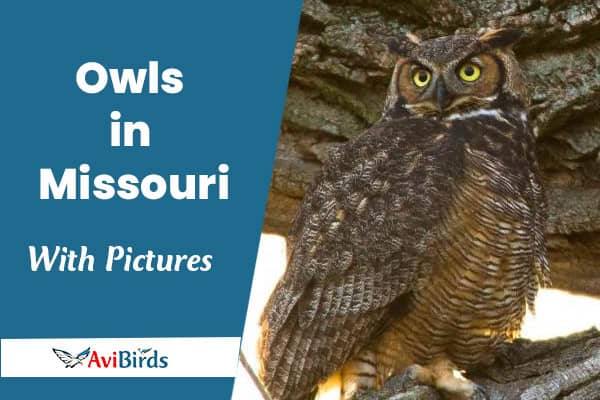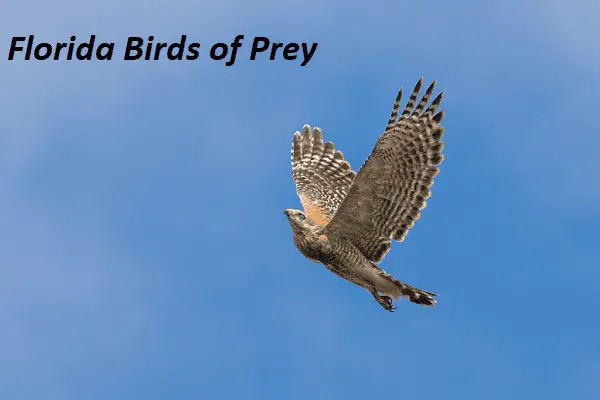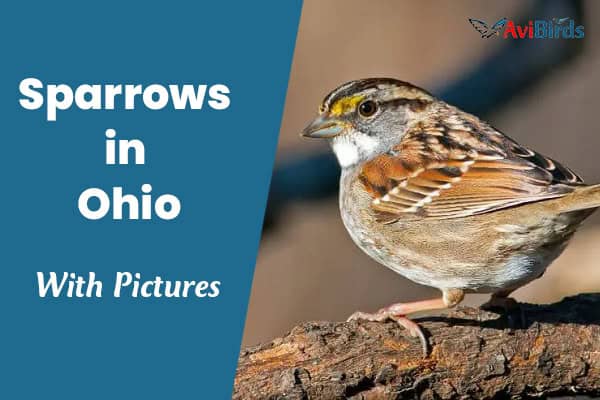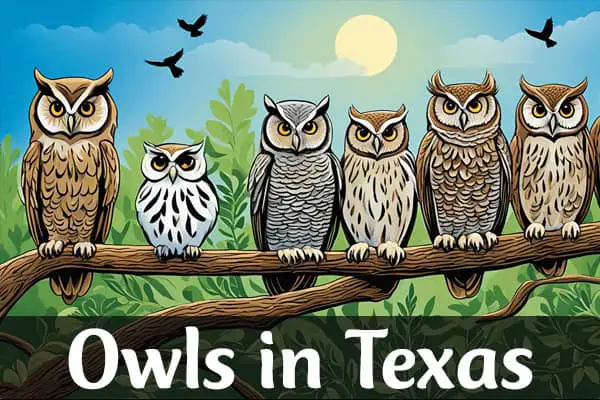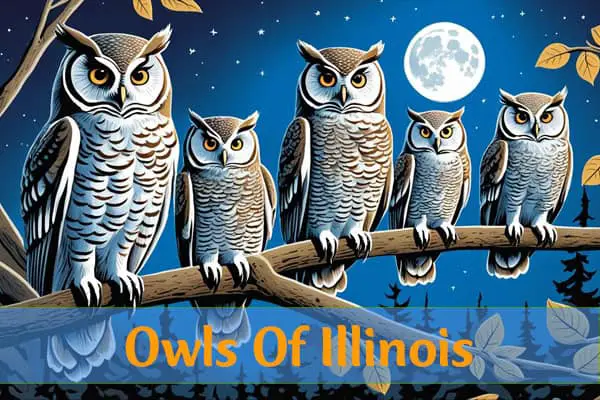8 Owls in Missouri (With Pictures)
Missouri has some really cool owls. I found out there are eight different kinds of them. They’re hard to spot because they hunt at night, but you can hear their spooky sounds. I’m going to tell you about where they live and what they eat. If you like learning about these night-time birds, keep reading to find out more about Missouri’s amazing owls!
Here we’ll learn about 8 different types of Owls in Missouri
1. American Barn Owl
- Scientific name: Tyto furcata
- Life span: 10 years
- Size: 34 to 38 cm
- Weight: 400 to 600 g
- Wingspan: 29 to 36 cm
- Status: Least Concern
The American Barn Owl is a cool bird with a ghost-like look. It hides in trees or bushes during the day and hunts at night. Also, This owl is part of a group that includes the Western and Eastern Barn Owls. It has light brown wings and a white face and belly.
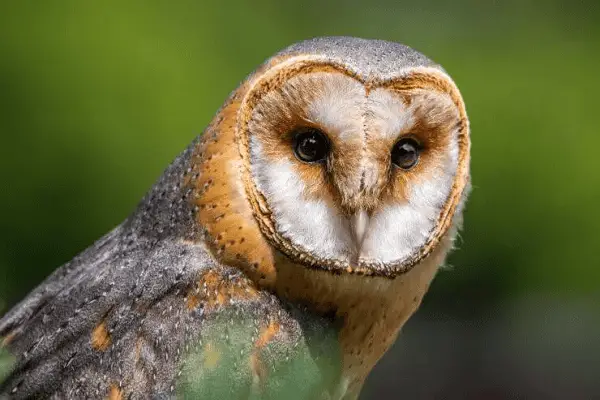
People have made up stories about it because of its unique face. The American Barn Owl pairs up for life and looks for a good place to live, like a tree hole or cliff, from March to June.
It eats mostly small animals like voles and mice, which it finds by sound, even in the dark. These owls need to eat a lot because they burn energy fast.
In North America, their numbers have gone down because of harmful chemicals in their food. But they’re tough and can bounce back quickly.
2. Barred Owl
- Scientific name: Strix varia
- Life span: 8 years
- Size: 40 to 63 cm
- Weight: 610 to 1,150 g
- Wingspan: 96 to 125 cm
- Status: Least Concern
Barred Owls are interesting birds that live close to where they were born, usually not going farther than 6 miles away. They have brownish-grey feathers with dark stripes and live in the eastern U.S. and southern Canada.
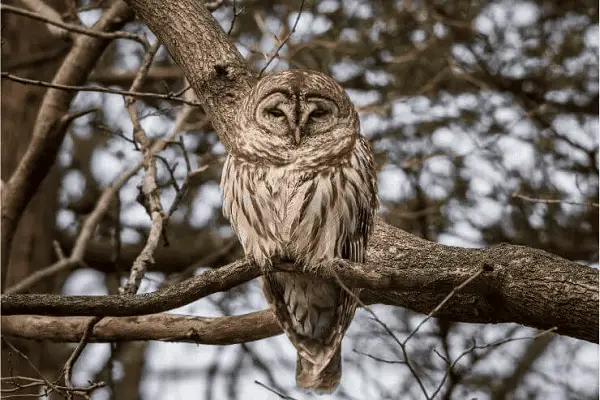
Like American Barn Owls, Barred Owls stay with the same partner for life. They start dating in February and make their homes in tree holes in thick forests.
These owls eat small animals like mice and sometimes bigger ones like rabbits. They have great hearing to find food near rivers and wetlands. They’re pretty common, with about 3 million of them around, and they’re doing okay, but they have to watch out for bad stuff in their food and changes to the forests they live in.
3. Long-eared Owl
- Scientific name: Asio otus
- Life span: 10 to 27 years
- Size: 31 to 40 cm
- Weight: 160 to 435 g
- Wingspan: 86 to 102 cm
- Status: Least Concern
The Long-Eared Owl is a bird that’s really good at hiding in trees because its feathers look like the bark and leaves around it. People might not even notice it’s there because it blends in so well.
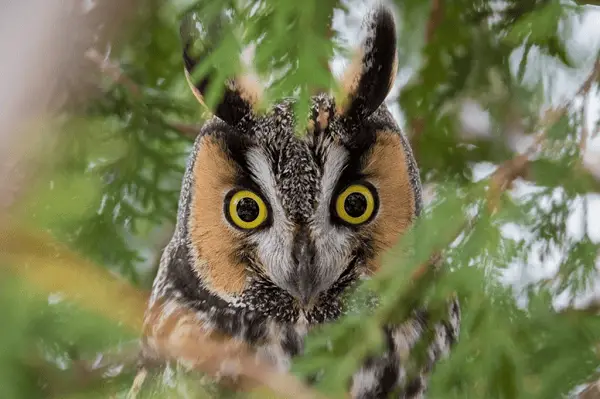
You can often hear these owls calling out in the woods, and they’re pretty loud. They start looking for mates and places to lay eggs in March. The boy owls make special sounds and do fancy wing dances to mark their territory, while the girl owls find cozy spots to nest, like abandoned nests from other birds or holes in trees.
Long-Eared Owls eat meat, mainly small animals like mice, shrews, and bugs. Sometimes they’ll even eat frogs or lizards if they’re really hungry. They’re not picky eaters!
When it’s time to eat, these owls like to sit and wait for their food to come close. But if they need to, they’ll fly low to the ground to find something tasty.
Sadly, even though there are Long-Eared Owls all around the world, their numbers are going down because they’re losing their homes and getting hit by cars.
4. Eastern Screech-Owl
- Scientific name: Megascops asio
- Life span: 8 to 10 years
- Size: 16 to 25 cm
- Weight: 121 to 244 g
- Wingspan: 46 to 61 cm
- Status: Least Concern
The Eastern Screech-Owl is a bird often seen in the eastern part of North America, even in Mexico. It’s cool because it can live in places where people have built things, and it doesn’t seem bothered by all the human activity.
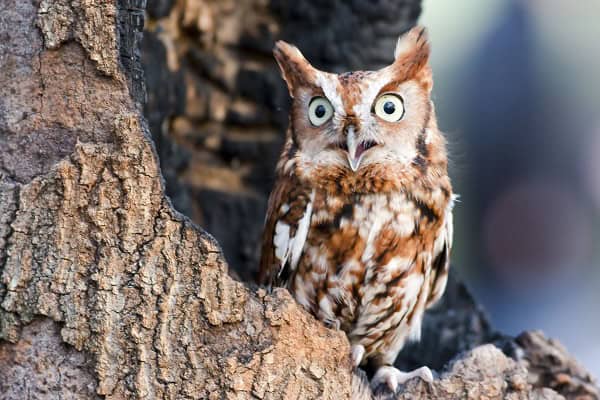
One interesting thing about this owl is that it comes in two colors – reddish in the south and grayish in the north. Experts think this happens because of where they live.
These owls like to live alone most of the time, but they get together in pairs when it’s time to have babies in April. They do special things together to make a strong bond that lasts their whole lives.
After they have babies, they make their homes in hollow tree trunks in dark forests. Even though they usually stick with their first partner, sometimes the male owl might find another mate in the same year and start a new family.
As hunters, they eat lots of different things. In Missouri, they mostly eat small animals like voles, mice, shrews, and rats. But they also eat bugs, reptiles, birds, and even fruits and berries. They do most of their hunting at night using their super hearing to find food. When they eat, they swallow their prey whole and then cough up the stuff they can’t digest, like bones and fur, in little balls called pellets.
5. Great Horned Owl
- Scientific name: Bubo virginianus
- Life span: 25 – 50 years
- Size: 43 to 64 cm
- Weight: 1200 to 1600 g
- Wingspan: 91 to 153 cm
- Status: Least Concern
The Great Horned Owl is a bird that can live in lots of different places, like deserts, wetlands, cities, and forests, all the way down to Brazil. They’re mostly active at night and their brown-speckled feathers help them blend in with their surroundings. Those “horns” you see on their heads are just feathery tufts that might help them talk to other owls, but scientists aren’t sure.
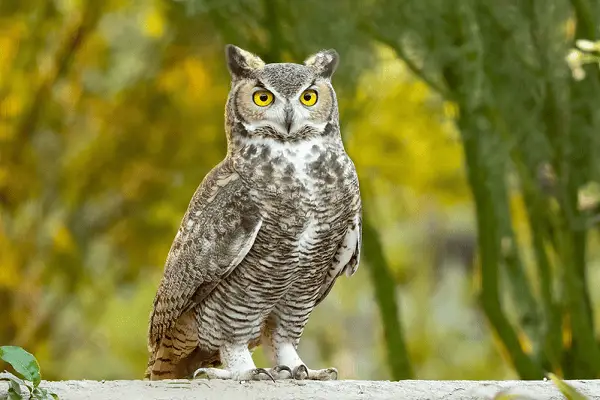
They start making babies really early in the year, sometimes as soon as January. The male owls do a fancy dance to impress the females and find a good place to have babies. They like to use old nests from big birds like hawks or eagles, and they can live in all kinds of places, from caves to cacti.
Great Horned Owls are really good at hunting. In places like Missouri, they eat mostly small animals like voles, mice, and rabbits. They hunt mostly at night and use their sharp claws and beaks to catch their prey.
Sadly, there aren’t as many Great Horned Owls as there used to be because of humans. People do things that hurt them, like shooting them, trapping them, hitting them with cars, or even poisoning them accidentally with rat poison. Farmers and hunters used to see them as pests because they ate chickens and small animals, so they would kill them. Some people still do that today, even though it’s not allowed. Even though they’re not officially in danger, their numbers going down is worrying.
6. Snowy Owl
- Scientific name: Bubo scandiacus
- Life span: 10 to 28
- Size: 52.5 to 64 cm
- Weight: 1706 to 2426 g
- Wingspan: 146 to 183 cm
- Status: Vulnerable
The Snowy Owl is a famous bird that lives in the Arctic during the summer and comes down to North America for winter. It’s easily recognized by its all-white feathers, which are some of the brightest in the animal world.

The males are whiter than the females, who have a mix of white and darker feathers. Unlike most owls, Snowy Owls are active during both day and night. This might be because in the Arctic, where they live, the length of the day changes a lot depending on the time of year.
Snowy Owls are really good at moving around. They travel long distances between where they breed in the summer and where they spend the winter, and this can change a lot from year to year.
Breeding season for Snowy Owls starts around April. The males do fancy flying tricks and sing songs to impress the females. They even bring them food and show them good places to make a nest. But unlike other owls, Snowy Owls don’t build nests – the female just makes a little hole in the ground to lay her eggs.
7. Short-eared Owl
- Scientific name: Asio flammeus
- Life span: 12 years
- Size: 34 to 43 cm
- Weight: 206 to 475 g
- Wingspan: 85 to 110 cm
- Status: Least Concern
The Short-Eared Owl is a common bird found in many parts of the world. It’s easy to spot with its small black beak and brown-speckled body, and it has distinct brown bars on its wings and tail.
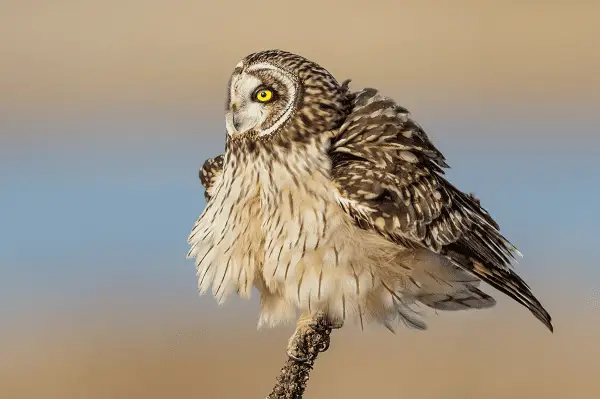
When it’s breeding season, which usually starts in March, Short-Eared Owls come together in temporary pairs and hang out in groups. They build their nests on the ground in places like prairies, meadows, and tundras, which is different from how most other owls nest.
Short-Eared Owls mostly eat small mammals like voles, shrews, and rodents, but they’ll also go for rabbits, weasels, and hares. Also, They’ll snack on other stuff too, like reptiles, amphibians, insects, and even birds like sparrows and larks.
These owls are smart hunters. They fly close to the ground during the day, especially in grassy areas, meadows, and other open places, looking for their next meal.
Check Our Previous Articles:
8. Northern Saw-whet Owl
- Scientific name: Aegolius acadicus
- Life span: 7 to 17 years
- Size: 17 to 22 cm
- Weight: 54 to 151 g
- Wingspan: 42 to 56.3 cm
- Status: Least Concern
The Northern Saw-Whet Owl is a small and secretive owl found in different parts of North America, including Missouri.

It’s easy to recognize with its round, cream-colored face marked with brown streaks, dark pointed beaks, and bright yellow eyes. Its body is brown with white spots on top and light-colored with brown marks underneath. Its name comes from the unique sound it makes, which sounds like a saw being sharpened on a whetstone.
During the breeding season, which starts around March, these owls pair up with one partner. However, if there’s lots of food around, males might have more than one mate. They usually nest in holes made by woodpeckers or in nest boxes made by humans.
In Missouri, Northern Saw-Whet Owls mostly eat small mammals like voles, mice, and shrews, but they’ll also go after insects, birds, and other little animals.
They’re smart hunters and can catch prey even in tight spaces, using their sharp claws and beaks. They can even take down prey that’s bigger than they are.
Where to Spot Owls in Missouri
Owls are most active early in the morning or late in the evening and live in places like forests, parks, and fields. Look for spots with tall trees and open areas.
Listening to their unique calls is a good way to find them, especially during breeding season in late winter or early spring.
In Missouri, you can find owls in places like Katy Trail State Park, Squaw Creek National Wildlife Refuge, Mark Twain National Forest, and around Smithville Lake.
When you’re looking for owls, be patient and quiet, and bring binoculars and a guidebook to help identify them.
Follow these tips and explore these areas, and you might get lucky and see one of Missouri’s amazing owls!
Frequently Asked Questions
Q1. What is the most common owl in Missouri?
The most common owl in Missouri is the Eastern Screech-Owl.
Q2. Can you have an owl in Missouri?
No, it’s illegal to possess owls as pets in Missouri without proper permits.
Q3. Does Missouri have snow owls?
Snowy Owls are not native to Missouri. They are typically found in Arctic regions and occasionally migrate to areas further south during winter, but they are not common in Missouri.
Q4. What is the owl habitat in Missouri?
Owls in Missouri inhabit various environments including woodlands, forests, parks, and fields. They prefer areas with tall trees, dense brush, and open spaces for hunting.

